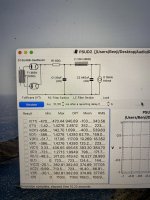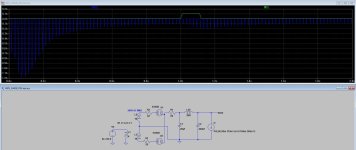Dear all
I have a tube headphone amplifier using a 6080 power tube with an output transformer. B+ is 360, current for both channels a little bit less than 100mA.
for the power supply I’m using a 5u4gb. On power on, if the room is dark I see some blue-violet light in the rectifier, mostly on the mica insulator. It disappears the moment the cathodes get red. I’m not shure if this is arching or not.
The psu is so made: center tap, 360x2(secodary resistance 0-360 48.4 ohm), one 22ohm resistor on each anode, 5u4gb->r 82 ohm-> c 22uF-> L 20 H -> C 220uf-> tl783 regulator and at the end another c 220uf. I have simulated the circuit in psud2. Since I cannot simulate the regulator I have simulated a big 440uf capacitor (I guess the regulator has a very low impendance) with an 10% increase in the drawn current. I don’t get any errors. I’ve tried to change the tube but I get the same results.
Any ideas?
Many thanks!
I have a tube headphone amplifier using a 6080 power tube with an output transformer. B+ is 360, current for both channels a little bit less than 100mA.
for the power supply I’m using a 5u4gb. On power on, if the room is dark I see some blue-violet light in the rectifier, mostly on the mica insulator. It disappears the moment the cathodes get red. I’m not shure if this is arching or not.
The psu is so made: center tap, 360x2(secodary resistance 0-360 48.4 ohm), one 22ohm resistor on each anode, 5u4gb->r 82 ohm-> c 22uF-> L 20 H -> C 220uf-> tl783 regulator and at the end another c 220uf. I have simulated the circuit in psud2. Since I cannot simulate the regulator I have simulated a big 440uf capacitor (I guess the regulator has a very low impendance) with an 10% increase in the drawn current. I don’t get any errors. I’ve tried to change the tube but I get the same results.
Any ideas?
Many thanks!
ok. but if it's really arching I would still guess that in the long run it will damage the tube and eve worse the transformer right?
I have an old AMP-196-AA running 6BQ5 outputs in SE. The rectifier is a 5U4-GB. About a month ago it blew it's fuse. When I replaced the fusee and turned it on I could definitely see an arc inside the rectifier. I replaced the rectifier and one of the output tubes which has a weak getter on the assumption the 6BQ5 may have been the initial cause.
Yes, you certainly can see the arc!
I replaced both the 6BQ5 and 5U4
Yes, you certainly can see the arc!
I replaced both the 6BQ5 and 5U4
Rectifier tube arcing at start up is too much current charging caps. You need to increase resistors to slow the charging.
Rectifier tube arcing randomly is short somewhere.
Rectifier tube arcing randomly is short somewhere.
The general opinion here seems to be newly made rectifier tubes are not as well made as their old versions. I understand that but at the same time rectifiers are much more simple than signal tubes.
In my case when the amp blew the fuse it had been of for hours. This was the original (60-04 1960 Magnavox) 5U4 tube in the original amp. The amp in my case was re-caped with appropriate caps. Most likely just got tired.Rectifier tube arcing at start up is too much current charging caps. You need to increase resistors to slow the charging.
Rectifier tube arcing randomly is short somewhere.
The OP tube does not sound like it is arcing.
Install a silicon diode in series with the tube rectifier plate can add some protection against rectifier arcing and increase rectifier tube life.ok. but if it's really arching I would still guess that in the long run it will damage the tube and eve worse the transformer right?
Add silicon diode to tube rectifier plate to eliminate arcing.
Thanks.
How do you explain that the arching appears to take place only before the cathodes are hot (red)?
Anyway I’ll try to increase the anode resistance and see how it goes.
Is it true that once a rectifier tube has arched it will have the tendency to arch easily even if the circuit is within the working parameters?
How do you explain that the arching appears to take place only before the cathodes are hot (red)?
Anyway I’ll try to increase the anode resistance and see how it goes.
Is it true that once a rectifier tube has arched it will have the tendency to arch easily even if the circuit is within the working parameters?
Please read post #7 by @Tubelab_com
https://www.diyaudio.com/community/threads/sparking-rectifier-tubes.202180/
https://www.diyaudio.com/community/threads/sparking-rectifier-tubes.202180/
A timing circuit with a relay to switch an extra 470ohm in series , or whatever you want , can easily be added ...
- Home
- Amplifiers
- Tubes / Valves
- Rectifier tube arcing?

